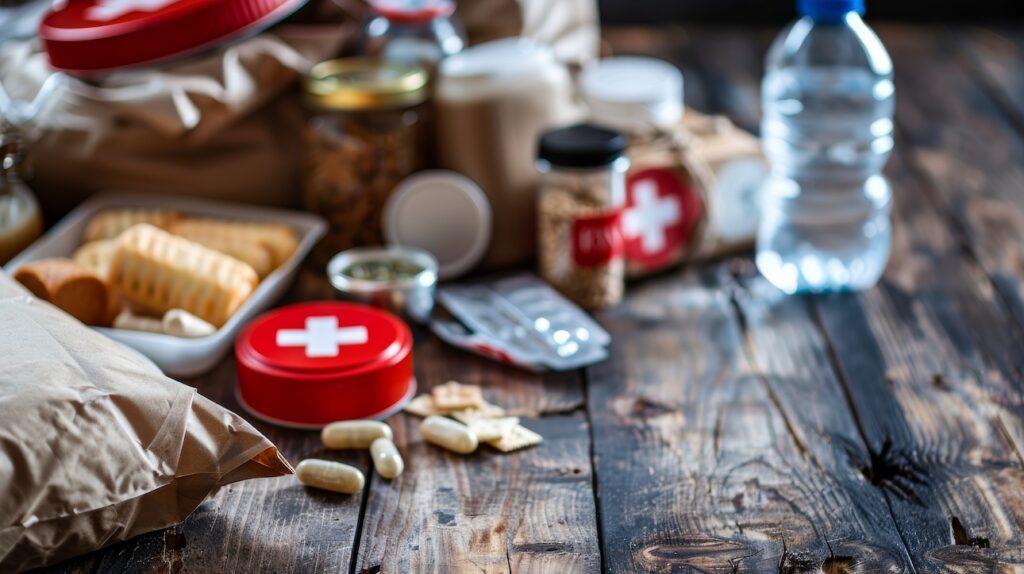Don’t Panic – But Do Get The Essentials
Some people might already be unnecessarily freaking out but it’s better to be safe than sorry. At the very least you still need a few essential supplies. You’ll want to have enough clean drinking water and nonperishable, easy-to-prepare food on hand for at least three days.
Each person in your family will need about a gallon of water a day according to FEMA, but you may want to store a little more for washing and food preparation. (Don’t forget to buy a non-electric can opener, if you don’t have one, so you can dig into those cans of beans.)
Prepare to Be Without Power
Don’t struggle to stay connected during or after a storm-induced power outage. Make sure all your cell phones and other mobile devices are currently charging, especially bigger devices like laptops that can then be used to power up smartphones if necessary.
You may also want to invest in an external battery pack or cordless charger if you’re making a last-minute run to Walmart.
Lengthen your gadgets’ lifespans by getting news from an old-fashioned hand-crank or cordless radio and by actually using a flashlight instead of the flashlight app on your phone. Just don’t forget to stock up on extra batteries.
Hit the ATM
If the power gets cut off in your area, you won’t have access to ATMs to get cash, so consider taking out $100 to $200 in small bills to use should any unforeseen emergency need pop up.
Fuel Up
Though you’re likely to stay off the roads once the storm begins, fill up your tank at the last opportunity before severe weather sets in, especially if you park your car on the street.
Get Your Pharmacy Refills
You’ll want to have at least a seven-day supply of any necessary medications on hand as well as any medical items you might need, such as extra hearing-aid batteries or backup contact lenses and a fully-stocked first-aid kit, recommends FEMA.
Consider replenishing stores of sanitation supplies like hand sanitizer and wet wipes to use if your water resources become limited.
Buy a Long Extension Cord
You could die from carbon monoxide poisoning if you use portable generators indoors, in attached garages, or too close to the house. And to use one safely outdoors, make sure you have a long enough extension cord to keep it at least 20 feet from any door, window, or vent.
You should also avoid the temptation to use any outdoor heating or cooking equipment like a grill, camp stove, or propane heater indoors, or to try to heat your home with the stove.
Gather Your Personal Documents
Before the storm comes, make sure you know where all important documents are kept, such as the deed/lease to your home, passports, birth certificates, and insurance policies; better still, gather them in a secure place.
That way you can access them quickly in case of a medical emergency or post-storm to file an insurance claim. You should also write down important phone numbers in case you can’t access the contact list in your phone.
Secure Outdoor Furniture
Loose items in your yard can become flying projectiles during a hurricane due to high winds. Move any unsecured items in your yard – including patio furniture, lawn chairs, bird feeders, hanging plants, and toys – inside your house or garage if possible. If you can’t move outdoor item in, use a strong rope or garden hose to tie them securely down.
Move Cars to Safety
Cars are often damaged or destroyed by falling trees or windblown debris during a hurricane. If you have a garage, park your cars in it and close the garage door. If not, position cars close to your home on the lee side of expected winds and away from trees to provide some shielding from the storm. Avoid parking cars near power lines or trees.
Find Utility Cutoffs
Identify the cutoff switches and valves for your water, power, and gas; and know how to turn them off in case of an emergency. Severe damage to your home from a hurricane can cause a short or power surge in your electrical system, and may also result in ruptured water or gas lines.
Cutoffs for water and gas are usually located at or near the meter for each utility. To turn off the power to your home, flip the main breaker in your circuit breaker box.
Fill Bathtub with Water
Whether you’re on city water or a well, water supplies can be disrupted or contaminated following a hurricane. Use the water in the bathtub to fill the tank on your toilet for flushing or for washing in the aftermath of a storm, but not for drinking.
Lining the tub with plastic before filling will keep water from leaking out of the tub drain.
Five-gallon buckets and pots from your kitchen can also be used to store water. After the storm has passed, water from a pool can be used for flushing toilets.
Gather Emergency Supplies
Gather the following items together in a laundry basket or small suitcase so they will be handy during and after a storm: flashlights, batteries, first aid kit, battery powered radio, cell phone car charger, hand sanitizer, prescription drugs, games, sunscreen, mosquito repellant, duct tape, toilet paper, important documents (including your homeowner’s insurance policy), pet and baby supplies.
Close Curtains, Shutters, and Blinds
To reduce the chance of flying glass if a window is blown out by high winds or flying debris, close shutters and blinds – both inside and out – along with drapes and curtains.
